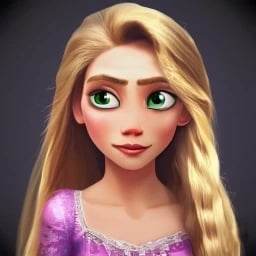Rapunzel’s Tower: A Tale Of Hope And Friendship
18th May 2023
Categorized Under: Short Stories
Comments (0)
RAPUNZEL’S TOWER: A TALE OF HOPE AND FRIENDSHIP
In a far-off kingdom, there was a young girl named Rapunzel. She lived in a tall tower, all alone, with only her long golden hair for company. But Rapunzel was not always alone. She once had friends and family, and she dreamed of one day seeing the world beyond her tower. This is the story of Rapunzel, a tale of hope, friendship, and the power of love to conquer all.
Once upon a time, there was a beautiful girl named Rapunzel who lived in a tall tower in the middle of a deep, dark forest. The tower had no doors or stairs, and the only way in or out was through a small window at the very top. Rapunzel had long, golden hair that flowed down from the window to the ground.
Rapunzel was very lonely in the tower, with no one to talk to except a wicked witch who had imprisoned her there. The witch had stolen Rapunzel from her parents when she was just a baby because the witch wanted to use Rapunzel’s magical hair to keep herself young and beautiful forever.
Years went by, and Rapunzel grew into a beautiful young woman with a lovely singing voice. One day, a prince was riding through the forest and heard Rapunzel singing. He followed the sound until he came upon the tower and saw Rapunzel’s long, golden hair flowing down from the window.
The prince was amazed and called out to Rapunzel, asking her to let down her hair so he could climb up and meet her. Rapunzel was hesitant at first, as the witch had warned her not to talk to strangers. But the prince was kind and charming, and Rapunzel soon found herself telling him all about her lonely life in the tower.
The prince and Rapunzel soon fell in love, but their happiness was short-lived. The wicked witch soon found out about the prince’s visits and was furious. She cut off Rapunzel’s hair and banished her to a far-off land, where she was forced to live in poverty and misery.
The prince was heartbroken when he returned to the tower and found it empty. But he never forgot about Rapunzel and searched for her far and wide. After many long years, he finally found her living in a small village. Though she was no longer the beautiful girl with the long, golden hair, the prince still loved Rapunzel and they lived happily ever after.
In the end, Rapunzel and the prince were happily reunited, and they lived together in the palace, surrounded by friends and family. Rapunzel was overjoyed to finally have the freedom and companionship she had always longed for. And though she still missed her tower from time to time, she knew that the world was full of wonders and adventures and that she would never be alone again. And so, with a happy heart and a head full of dreams, Rapunzel looked forward to a bright and beautiful future, filled with endless possibilities.
The End.
A FEW LESSER-KNOWN FACTS ABOUT THE STORY OF RAPUNZEL:
• The original version of the story was much darker and more violent than the popular version we know today. In the original version, Rapunzel becomes pregnant by the prince and the witch finds out, cutting off Rapunzel’s hair and banishing her to a desert. The prince is blinded by thorns and wanders the wilderness for years until he finally finds Rapunzel and their children.
• The story of Rapunzel has its roots in many different cultures and has been retold in many different forms. The earliest known version of the story dates back to ancient Persia, where it was called “The Tale of the Hairy One.”
• The Grimm brothers’ version of Rapunzel is an amalgamation of several different stories they collected from various sources. They published their version in 1812, as part of their collection of fairy tales.
• The story of Rapunzel has been interpreted in many different ways. Some see it as a cautionary tale about the dangers of disobeying one’s parents or being too trusting of strangers. Others see it as a story about the power of love to overcome obstacles and bring people together.
• In some versions of the story, Rapunzel’s hair is not just long, but also magical. It is said to have healing powers or the ability to grant wishes.
• The name “Rapunzel” is derived from the German word “Rapunzel,” which means “rampion,” a type of vegetable with long, slender roots. In the original version of the story, the witch discovers a rampion growing in Rapunzel’s parents’ garden and demands that they give her the child in exchange for the rampion.
• In some older versions of the story, Rapunzel is not rescued by a prince, but by a shepherd or a knight. The character of the prince is a later addition to the tale.
RAPUNZEL´S PERSONALITY:
In the traditional story of Rapunzel, her personality is not explicitly described, but she is portrayed as a kind and gentle young woman who longs for freedom and companionship. Despite being trapped in a tower by a wicked witch, Rapunzel maintains her optimism and hope for a better life.
Throughout the story, Rapunzel is depicted as innocent and naive, as she is easily tricked by the witch’s lies and initially hesitant to trust the prince who comes to rescue her. However, she also shows bravery and resourcefulness when she uses her hair to help the prince climb up to the tower and later stands up to the witch to protect the man she loves.
Rapunzel is often seen as a symbol of purity, innocence, and hope, despite the challenges she faces in the story. She is a sympathetic and relatable character whose longing for connection and freedom resonates with many readers and audiences.
POTENTIAL MORALS THAT CAN BE DERIVED FROM THE TALE:
• The power of perseverance: Rapunzel’s story teaches us the importance of resilience and never giving up. Despite being trapped in a tower, she remains hopeful and eventually finds a way to escape. The moral here is to keep striving for your goals even in challenging circumstances.
• The consequences of greed and selfishness: The witch’s actions in imprisoning Rapunzel for her gain illustrate the negative consequences of greed and selfishness. This moral teaches us to consider the impact our actions have on others and to prioritize kindness and empathy over personal gain.
• The strength of love and friendship: Rapunzel’s love for Prince Ferdinand and their unwavering support for each other highlights the power of love and friendship. The moral here is that genuine connections and caring relationships can help overcome obstacles and bring happiness.
• The importance of independence and self-discovery: Rapunzel’s desire to explore the world beyond her tower reflects the significance of independence and self-discovery. The story encourages individuals to venture out, discover their passions, and embrace new experiences.
POSSIBLE MOTIVES FOR THE WITCH’S ACTIONS:
-
Rapunzel’s magical hair: In some versions, Rapunzel’s long, golden hair possesses magical properties. The witch desires to harness the power of Rapunzel’s hair for her gain, using it to maintain her youth or perform spells.
-
Revenge or jealousy: The witch may hold a grudge or feel jealous towards Rapunzel or her parents. This could stem from a perceived slight or personal vendetta, leading the witch to imprison Rapunzel as an act of retribution.
-
Protection or control: The witch may believe that Rapunzel is safer or easier to control if she is isolated in the tower. The witch might fear that others would try to exploit Rapunzel’s unique qualities or harm her in some way.
-
Selfishness and possessiveness: The witch may view Rapunzel as her property, exerting control over her and denying her freedom out of possessiveness or a sense of entitlement.
DESCRIPTION OF THE TOWER AND THE WINDOW:
THE TOWER:
The tower stands proud and solitary, reaching towards the sky like a sentinel of solitude. Its stone walls, weathered by time, exude an air of mystery and secrecy. Rising high above the surrounding landscape, it seems to whisper secrets to the passing wind. The tower’s architecture is elegant yet simple, with slender turrets and intricate details adorning its facade. It stands as a symbol of isolation, a sanctuary that holds both beauty and confinement within its walls.
THE WINDOW:
Nestled within the tower is a small, arched window that becomes Rapunzel’s sole connection to the outside world. Framed by vines and delicate blossoms, it offers a glimpse into a world beyond her reach. The window is like a portal of hope, through which Rapunzel gazes longingly, yearning for freedom and adventure. Its glass, polished by Rapunzel’s tender touch, gleams like a beacon, reflecting the dreams and desires hidden within her heart. It serves as a symbol of longing, a small aperture of light that holds the promise of a different destiny.
Kidsinco’s Related Posts:
Rapunzel’s Enchanting Adventure – Play Script
Rapunzel’s Escape – Play Script
Rapunzel – Play Script
Kidsinco’s Myths and Legends from Around the World
Click here to read Kidsinco’s Complete List of Playscripts:
Page 1
Page 2
Page 3
Page 4
Please read our Terms of Use
Kidsinco play scripts, myths, legends, and short stories are not for sale, and they may not be republished totally or partially on any other website, blog, forum, book, or textbook. If you want to share our scripts, please place a link to this site
Tags: Rapunzel fairy tale, Rapunzel story



